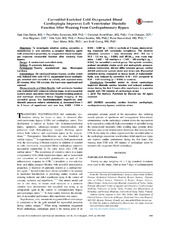| dc.Published | Dahle GO, Salminen P, Moen CA, Eliassen F, Nygreen EL, Kytö, Saukko, Haaverstad R, Matre K, Grong K. Carvedilol-enriched cold oxygenated blood cardioplegia improves left ventricular diastolic function after weaning from cardiopulmonary bypass. Journal of Cardiothoracic and Vascular Anesthesia. 2016;30(4):859-868 | eng |
| dc.description.abstract | Objectives: To investigate whether adding carvedilol, a nonselective β- and selective α1-receptor blocking agent with antioxidant properties, to oxygenated blood cardioplegia improves myocardial function after weaning from bypass. Design: A randomized controlled study. Setting: A university laboratory. Participants: Twenty anesthetized pigs, Norwegian Landrace. Interventions: On cardiopulmonary bypass, cardiac arrest was induced with cold (12°C), oxygenated blood cardioplegia, enriched with carvedilol or vehicle, and repeated every 20 minutes. After 100 minutes, the heart was reperfused and weaned. Measurements and Main Results: Left ventricular function was evaluated with pressure-volume loops, local myocardial systolic strain, and strain rate from Speckle tracking analysis and multilayer short-axis tissue Doppler Imaging. In the carvedilol group, the load-independent logarithmic end-diastolic pressure volume relationship, β, decreased from 1 to 3 hours of reperfusion and was low, 0.028±0.004 v 0.042±0.007 (p<0.05) in controls at 3 hours, demonstrating improved left ventricular compliance. The diastolic relaxation constant τ was decreased, 28.9±0.6 ms v 34.6±1.3 ms (pg<0.035), and dP/dtmin was more negative,−1,462±145 mmHg/s v−1,105±105 mmHg/s (pg = 0.024), for carvedilol v control group. The systolic variables, preload recruitable stroke work and end-systolic pressure-volume relationship, did not differ between groups, neither did left ventricular systolic strain and strain rate. Myocardial oxidative stress, measured as tissue levels of malondialdehyde, was reduced by carvedilol, 0.19±0.01 compared to 0.24±0.01 nmol/mg (p = 0.004) in controls. Conclusions: Carvedilol added to blood cardioplegia improved diastolic cardiac function and reduced oxidative stress during the first 3 hours after reperfusion in a porcine model, with 100 minutes of cardioplegic arrest. | en_US |

